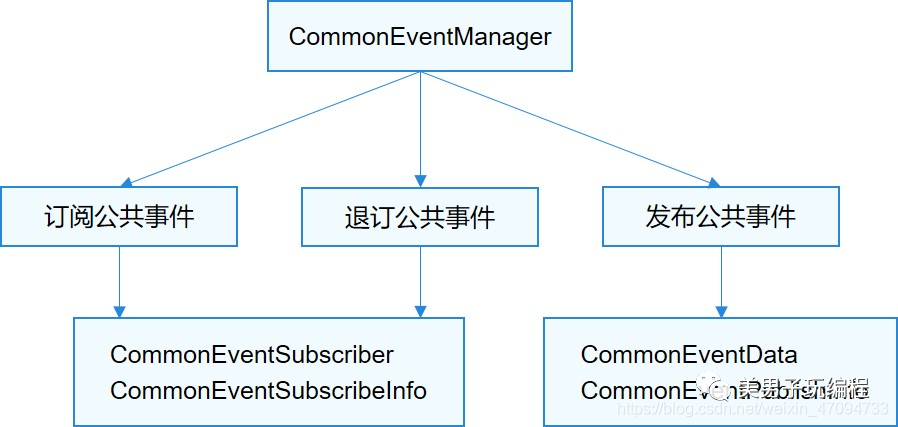HarmonyOS学习路之开发篇—公共事件与通知(一)
1
公共事件与通知开发概述
HarmonyOS通过CES(Common Event Service,公共事件服务)为应用程序提供订阅、发布、退订公共事件的能力,通过ANS(Advanced Notification Service,即通知增强服务)系统服务来为应用程序提供发布通知的能力。
公共事件可分为系统公共事件和自定义公共事件。 系统公共事件:系统将收集到的事件信息,根据系统策略发送给订阅该事件的用户程序。例如:用户可感知亮灭屏事件,系统关键服务发布的系统事件(例如:USB插拔,网络连接,系统升级等)。 自定义公共事件:应用自定义一些公共事件用来处理业务逻辑。 通知提供应用的即时消息或通信消息,用户可以直接删除或点击通知触发进一步的操作。 IntentAgent封装了一个指定行为的Intent,可以通过IntentAgent启动Ability和发布公共事件。
应用如果需要接收公共事件,需要订阅相应的事件。
2
公共事件开发
接口说明
公共事件相关基础类包含CommonEventData、CommonEventPublishInfo、CommonEventSubscribeInfo、CommonEventSubscriber和CommonEventManager。基础类之间的关系如下图所示:
 图1 公共事件基础类关系图
图1 公共事件基础类关系图
CommonEventData
CommonEventData封装公共事件相关信息。用于在发布、分发和接收时处理数据。在构造CommonEventData对象时,相关参数需要注意以下事项:
code为有序公共事件的结果码,data为有序公共事件的结果数据,仅用于有序公共事件场景。 intent不允许为空,否则发布公共事件失败。
CommonEventPublishInfo
CommonEventPublishInfo封装公共事件发布相关属性、限制等信息,包括公共事件类型(有序或粘性)、接收者权限等。
有序公共事件:主要场景是多个订阅者有依赖关系或者对处理顺序有要求,例如:高优先级订阅者可修改公共事件内容或处理结果,包括终止公共事件处理;或者低优先级订阅者依赖高优先级的处理结果等。 粘性公共事件:指公共事件的订阅动作是在公共事件发布之后进行,订阅者也能收到的公共事件类型。主要场景是由公共事件服务记录某些系统状态,如蓝牙、WLAN、充电等事件和状态。CommonEventSubscribeInfoCommonEventSubscribeInfo封装公共事件订阅相关信息,比如优先级、线程模式、事件范围等。线程模式(ThreadMode):设置订阅者的回调方法执行的线程模式。ThreadMode有HANDLER,POST,ASYNC, BACKGROUND四种模式,目前只支持HANDLER模式。 HANDLER:在Ability的主线程上执行。 POST:在事件分发线程执行。 ASYNC:在一个新创建的异步线程执行。 BACKGROUND:在后台线程执行。
CommonEventSubscriber
CommonEventSubscriber封装公共事件订阅者及相关参数。
CommonEventSubscriber.AsyncCommonEventResult类处理有序公共事件异步执行。 目前只能通过调用CommonEventManagersubscribeCommonEvent()进行订阅。
CommonEventManager
CommonEventManager是为应用提供订阅、退订和发布公共事件的静态接口类。
3
Demo实例程序
效果演示如下所示:
4
发布公共事件
四种公共事件:无序的公共事件、带权限的公共事件、有序的公共事件、粘性的公共事件。
发布无序的公共事件:构造CommonEventData对象,设置Intent,通过构造operation对象把需要发布的公共事件信息传入intent对象。然后调用 CommonEventManager.publishCommonEvent(CommonEventData) 接口发布公共事件。
public void publishDisorderedEvent() {
Intent intent = new Intent();
Operation operation = new Intent.OperationBuilder().withAction(event).build();
intent.setOperation(operation);
CommonEventData eventData = new CommonEventData(intent);
try {
CommonEventManager.publishCommonEvent(eventData);
showTips(context, "Publish succeeded");
} catch (RemoteException e) {
HiLog.error(LABEL_LOG, "%{public}s", "publishDisorderedEvent remoteException.");
}
}
发布携带权限的公共事件:构造CommonEventPublishInfo对象,设置订阅者的权限。
在config.json中申请所需的权限
"reqPermissions": [
{
"name": "ohos.samples.permission",
"reason": "get right",
"usedScene": {
"ability": [
".MainAbilitySlice"
],
"when": "inuse"
}
}
]
发布带权限的公共事件示例代码如下
public void publishPermissionEvent() {
Intent intent = new Intent();
Operation operation = new Intent.OperationBuilder().withAction(event).build();
intent.setOperation(operation);
CommonEventData eventData = new CommonEventData(intent);
CommonEventPublishInfo publishInfo = new CommonEventPublishInfo();
String[] permissions = {"ohos.sample.permission"};
publishInfo.setSubscriberPermissions(permissions);
try {
CommonEventManager.publishCommonEvent(eventData, publishInfo);
showTips(context, "Publish succeeded");
} catch (RemoteException e) {
HiLog.error(LABEL_LOG, "%{public}s", "publishPermissionEvent remoteException.");
}
}
发布有序的公共事件:构造CommonEventPublishInfo对象,通过setOrdered(true)指定公共事件属性为有序公共事件,也可以指定一个最后的公共事件接收者。
public void publishOrderlyEvent() {
MatchingSkills skills = new MatchingSkills();
Intent intent = new Intent();
Operation operation = new Intent.OperationBuilder().withAction(event).build();
intent.setOperation(operation);
CommonEventData eventData = new CommonEventData(intent);
skills.addEvent(event);
CommonEventPublishInfo publishInfo = new CommonEventPublishInfo();
publishInfo.setOrdered(true);
try {
CommonEventManager.publishCommonEvent(eventData, publishInfo);
showTips(context, "Publish succeeded");
} catch (RemoteException e) {
HiLog.error(LABEL_LOG, "%{public}s", "publishOrderlyEvent remoteException.");
}
}
发布粘性公共事件:构造CommonEventPublishInfo对象,通过setSticky(true)指定公共事件属性为粘性公共事件。
发布者首先在config.json中申请发布粘性公共事件所需的权限
"reqPermissions": [
{
"name": "ohos.permission.COMMONEVENT_STICKY",
"reason": "get right",
"usedScene": {
"ability": [
".MainAbilitySlice"
],
"when": "inuse"
}
}
]
发布粘性公共事件
public void publishStickyEvent() {
Intent intent = new Intent();
Operation operation = new Intent.OperationBuilder().withAction(event).build();
intent.setOperation(operation);
CommonEventData eventData = new CommonEventData(intent);
CommonEventPublishInfo publishInfo = new CommonEventPublishInfo();
publishInfo.setSticky(true);
try {
CommonEventManager.publishCommonEvent(eventData, publishInfo);
showTips(context, "Publish succeeded");
} catch (RemoteException e) {
HiLog.error(LABEL_LOG, "%{public}s", "publishStickyEvent remoteException.");
}
}
5
订阅公共事件
1、创建CommonEventSubscriber派生类,在onReceiveEvent()回调函数中处理公共事件。
class TestCommonEventSubscriber extends CommonEventSubscriber {
TestCommonEventSubscriber(CommonEventSubscribeInfo info) {
super(info);
}
@Override
public void onReceiveEvent(CommonEventData commonEventData) {
}
}
2、构造MyCommonEventSubscriber对象,调用CommonEventManager.subscribeCommonEvent()接口进行订阅。
String event = "测试";
MatchingSkills matchingSkills = new MatchingSkills();
matchingSkills.addEvent(event); // 自定义事件
CommonEventSubscribeInfo subscribeInfo = new CommonEventSubscribeInfo(matchingSkills);
TestCommonEventSubscribersubscriber = new TestCommonEventSubscriber(subscribeInfo);
try {
CommonEventManager.subscribeCommonEvent(subscriber);
} catch (RemoteException e) {
HiLog.error(LABEL, "Exception occurred during subscribeCommonEvent invocation.");
}
如果订阅的公共事件是有序的,可以调用setPriority()指定优先级。
String event = "测试";
MatchingSkills matchingSkills = new MatchingSkills();
matchingSkills.addEvent(event); // 自定义事件
CommonEventSubscribeInfo subscribeInfo = new CommonEventSubscribeInfo(matchingSkills);
subscribeInfo.setPriority(100); // 设置优先级,优先级取值范围[-1000,1000],值默认为0。
TestCommonEventSubscribersubscriber subscriber = new TestCommonEventSubscribersubscriber (subscribeInfo);
try {
CommonEventManager.subscribeCommonEvent(subscriber);
} catch (RemoteException e) {
HiLog.error(LABEL, "Exception occurred during subscribeCommonEvent invocation.");
}
3、针对在onReceiveEvent中不能执行耗时操作的限制,可以使用CommonEventSubscriber的goAsyncCommonEvent()来实现异步操作,函数返回后仍保持该公共事件活跃,且执行完成后必须调用AsyncCommonEventResult .finishCommonEvent()来结束。
EventRunner runner = EventRunner.create(); // EventRunner创建新线程,将耗时的操作放到新的线程上执行
MyEventHandler myHandler = new MyEventHandler(runner); // MyEventHandler为EventHandler的派生类,在不同线程间分发和处理事件和Runnable任务
@Override
public void onReceiveEvent(CommonEventData commonEventData){
final AsyncCommonEventResult result = goAsyncCommonEvent();
Runnable task = new Runnable() {
@Override
public void run() {
........ // 待执行的操作,由开发者定义
result.finishCommonEvent(); // 调用finish结束异步操作
}
};
myHandler.postTask(task);
}
6
退订公共事件
在Ability的onStop()中调用CommonEventManager.unsubscribeCommonEvent()方法来退订公共事件。调用后,之前订阅的所有公共事件均被退订。
public void unSubscribeEvent() {
if (subscriber == null) {
HiLog.info(LABEL_LOG, "%{public}s", "CommonEvent onUnsubscribe commonEventSubscriber is null");
return;
}
try {
CommonEventManager.unsubscribeCommonEvent(subscriber);
showTips(context, "UnSubscribe succeeded");
} catch (RemoteException e) {
HiLog.error(LABEL_LOG, "%{public}s", "unsubscribeEvent remoteException.");
}
destroy();
}
private void destroy() {
subscriber = null;
eventListener = null;
unSubscribe = true;
}
 往期推荐
往期推荐

